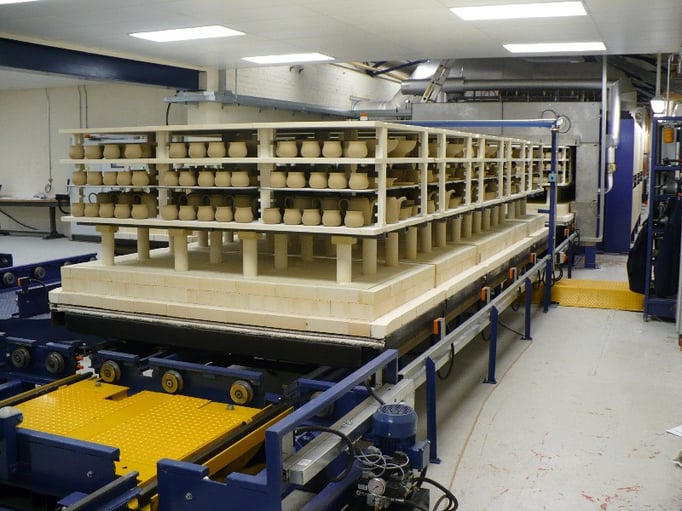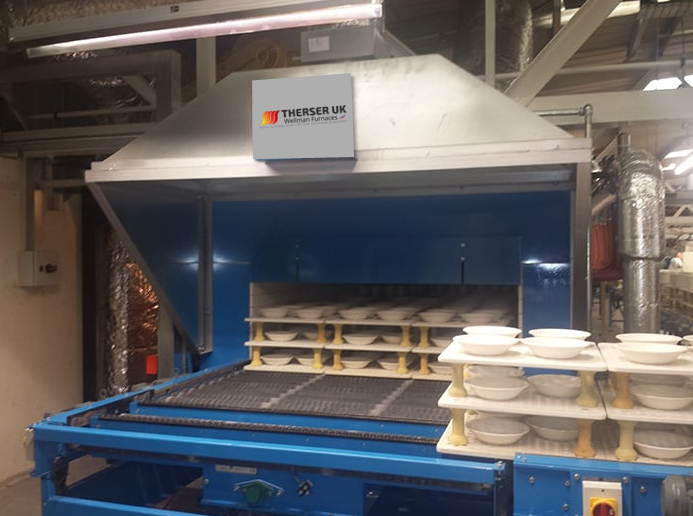Share this
The Ultimate Guide to Using a Tunnel Kiln for Firing Ceramics
by Therser UK on 16-Apr-2024 08:44:36
Firing pottery or tableware in a tunnel kiln is a complex process that involves various technical stages, each critical to achieving the desired quality and characteristics of the ceramic products. Here’s a detailed explanation of the stages.

1. Preparation and Loading
Before firing, ensure that all ceramic pieces are bone dry and free of any surface impurities. This initial preparation is crucial to prevent defects such as cracking or explosions within the kiln. Loading techniques vary depending on the type of ware being fired but generally involve spacing the pieces on kiln cars or conveyors to ensure even exposure to heat. It’s vital to arrange pieces so that air and heat can circulate freely around each piece, which helps achieve uniform firing results. Use kiln furniture wisely to maximize space while maintaining stability and airflow.
2. Water Smoking and Dehydration
The water smoking and dehydration stage is essential for safely removing physical water (moisture) from the clay. This phase takes place at a low temperature, typically between 100-200°C (212-392°F), and can last several hours depending on the thickness and density of the loaded pieces. The slow and controlled increase in temperature prevents thermal shock, which can cause cracking or warping. It’s critical to monitor this phase closely, as rapid temperature changes can damage the ceramic integrity.
3. Quartz Inversion
Quartz inversion occurs at about 573°C (1063°F), where the silica present in the clay undergoes a reversible transformation in its crystal structure. This transformation is associated with a slight volume expansion, which can induce stress within the ceramic if not managed correctly. The key to successfully navigating this stage is to approach and pass through the inversion point at a controlled, steady rate of heating. Ensuring a smooth temperature transition during this critical phase helps in minimizing the risk of cracking or other structural failures.
4. Oxidation and Bisque Firing
During the oxidation stage, all remaining organic material in the clay body is oxidized and burned off. This is critical for improving the structural integrity and color of the final product. The bisque firing follows, where temperatures reach between 1000°C and 1280°C (1832°F to 2336°F). This high-temperature phase leads to vitrification, where the clay body turns into a dense, stone-like material with a glassy matrix. Achieving the correct temperature and maintaining it long enough is crucial for the clay to mature properly.
5. Cooling
Controlled cooling is as important as the heating process. Ceramics need to be cooled gradually to avoid inducing thermal shock. Cooling typically involves carefully reducing the kiln temperature, allowing the ceramics to adjust to the lower temperatures without developing stresses that can lead to cracking. The cooling process must also manage the second quartz inversion, ensuring that as the quartz contracts, it does not cause the ceramic to crack or weaken structurally.

6. Unloading and Post-Processing
Once the kiln has reached room temperature, unloading should be undertaken with care to avoid damaging the now fragile ceramic pieces. Post-processing steps may include glazing, which requires another round of firing, or applying decorative elements. This stage is also an opportunity to inspect each piece for defects and to perform any necessary touch-ups or refinishing, which could improve the appearance or durability of the ceramics.
7. Safety and Maintenance
Operating a tunnel kiln safely requires adherence to several safety protocols. Workers should wear protective gear, including heat-resistant gloves and eyewear, and be trained in emergency procedures. Regular maintenance of the kiln is crucial to ensure its efficient operation and to prevent mechanical failures. This includes checking the integrity of the kiln lining, ensuring that heating elements and thermocouples are functioning properly, and cleaning the kiln to remove any debris or buildup.
8. Troubleshooting Common Issues
Common issues in tunnel kiln operations include cracking, deformation, or incomplete firing of ceramics. Troubleshooting these issues typically involves adjusting the firing schedule, temperature curves, or the positioning of pieces within the kiln. Operators should keep detailed records of each firing, noting any changes in materials or procedures that might affect the outcomes. This documentation can help in diagnosing the cause of defects and developing solutions to prevent recurrence.
For all enquires about Tunnel Kilns
Tel 01782 824453
Share this
- Company News (90)
- Battery Materials (41)
- kiln (37)
- fabrication (29)
- Alloy (27)
- Furnace (27)
- Welding (16)
- Industrial Kilns (15)
- Battery (13)
- Ceramic Kilns (13)
- Processes (13)
- alloy fabrication (13)
- Shuttle Kilns (12)
- RTO’s (11)
- Vacancies (11)
- Hydrogen (10)
- Therser UK (9)
- Tunnel Kiln (9)
- Refractory (8)
- Therser (8)
- Wellman Furnaces (8)
- Brickwork (7)
- Case Studies (7)
- Afterburners (6)
- Fibre Lining (6)
- electric (6)
- Almor Wellman (5)
- thermal engineers (5)
- Biochar (4)
- Exhibition (4)
- Pyrolysis (4)
- Servicing (4)
- Spares (4)
- heat treatment (4)
- History (3)
- Ceramics Uk (2)
- Combustion Control Upgrades (2)
- Nitrogen (2)
- Temperature Control Rings (2)
- gas (2)
- Certificates (1)
- Instrumentation (1)
- MMC (1)
- RHK (1)
- Roller Hearth Kiln (1)
- Test Trials (1)
- aerospace (1)
- analyser (1)
- elec (1)
- oxygen (1)
- vans (1)
- September 2025 (2)
- May 2025 (2)
- March 2025 (1)
- February 2025 (2)
- January 2025 (5)
- December 2024 (5)
- November 2024 (7)
- October 2024 (5)
- September 2024 (4)
- August 2024 (14)
- July 2024 (13)
- June 2024 (2)
- May 2024 (5)
- April 2024 (13)
- March 2024 (8)
- February 2024 (12)
- January 2024 (14)
- December 2023 (6)
- November 2023 (12)
- October 2023 (24)
- September 2023 (11)
- August 2023 (11)
- July 2023 (9)
- June 2023 (15)
- May 2023 (53)
- April 2023 (5)
- March 2023 (6)
- February 2023 (7)
- January 2023 (3)
- December 2022 (8)
- November 2022 (5)
- October 2022 (11)
- September 2022 (1)
- August 2022 (2)
- July 2022 (1)
- June 2022 (2)
- May 2022 (1)
- March 2022 (1)
- February 2022 (1)
- January 2022 (1)
- December 2021 (3)
- October 2021 (1)
- August 2021 (1)
- June 2021 (1)
- May 2021 (4)
- April 2021 (2)
- March 2021 (4)
- February 2021 (2)
- December 2020 (3)
- November 2020 (1)
- September 2020 (3)
- May 2020 (1)
- April 2020 (2)
- March 2020 (1)
- January 2020 (1)
- December 2019 (1)
- July 2019 (2)
- June 2019 (1)
- April 2019 (2)
- March 2019 (3)
- February 2019 (4)
- December 2018 (1)
- November 2018 (1)
- September 2018 (2)
- August 2018 (1)
- July 2018 (1)
- May 2018 (3)
- April 2018 (1)
- February 2018 (3)
- January 2018 (2)
- December 2017 (3)
- November 2017 (1)
- October 2017 (2)
- September 2017 (4)
- August 2017 (1)
- July 2017 (2)
- June 2017 (2)
- May 2017 (3)
- April 2017 (3)

